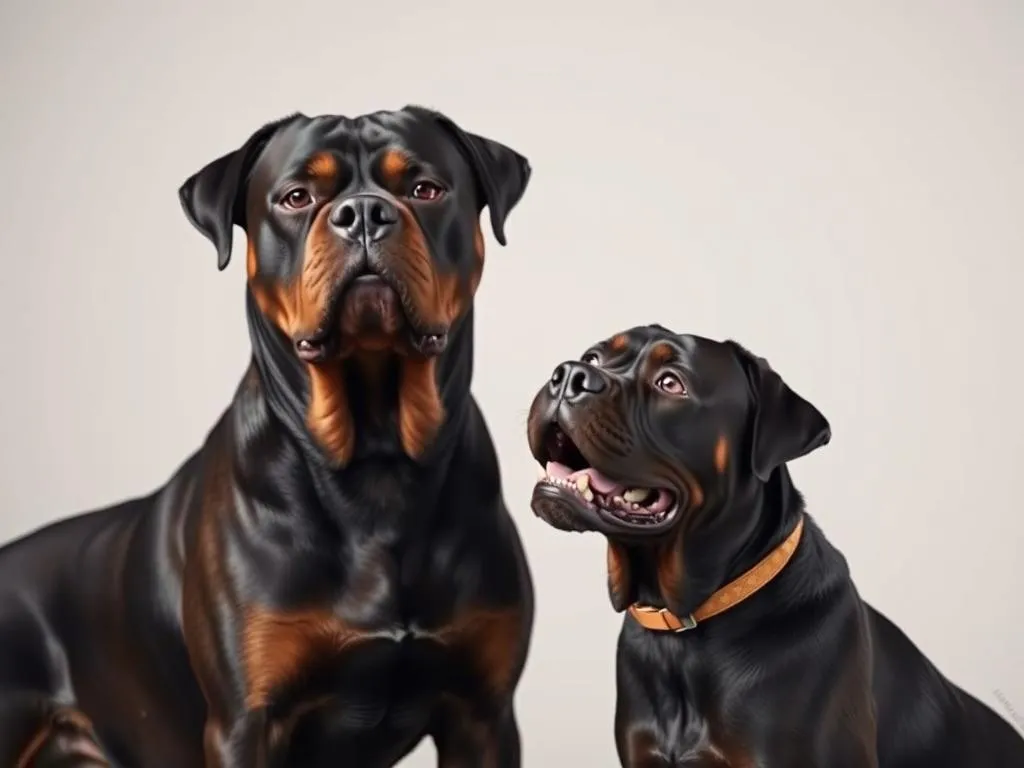
Choosing the right dog breed is a significant decision that can impact your lifestyle and family dynamics. Among the popular large dog breeds, the Cane Corso and the Rottweiler stand out for their impressive physiques and strong personalities. Understanding the characteristics of these breeds is vital for potential dog owners to make informed choices that align with their lifestyles and preferences.
General Overview of Cane Corso and Rottweiler
Cane Corso
History and Origin
The Cane Corso hails from Italy, where it has deep historical roots as a guardian and hunting dog. Initially bred to assist in herding livestock, this breed has evolved into a loyal protector of homes and families. The Cane Corso’s lineage can be traced back to the Roman “Canis Pugnax,” a large dog used for various tasks, including war.
Physical Characteristics
Cane Corsos are robust and muscular, with males typically weighing between 110 to 150 pounds and females ranging from 80 to 110 pounds. Standing 24 to 28 inches tall at the shoulder, they possess a short, dense coat that comes in various colors, including black, fawn, and brindle.
Temperament
The Cane Corso is known for its loyalty and protective nature. They are typically reserved with strangers but form strong bonds with their families. This breed is intelligent and eager to please, making them trainable but also requiring consistent leadership.
Lifespan and Health Concerns
On average, Cane Corsos live between 10 to 12 years. Common health issues include hip dysplasia, heart problems, and certain genetic conditions, so regular veterinary care is essential for maintaining their health.
Rottweiler
History and Origin
The Rottweiler has German origins, originally bred for herding and guarding livestock. This breed gained popularity for its strength and protective instincts, often serving as police and service dogs due to their confident and fearless nature.
Physical Characteristics
Rottweilers are similarly impressive in size, with males weighing between 95 to 135 pounds and females ranging from 80 to 100 pounds. They stand about 22 to 27 inches tall, displaying a well-defined muscular build. Their short, black coat features distinctive tan markings.
Temperament
Rottweilers are known for their intelligence and loyalty. They tend to be confident and assertive, making them excellent guardians. While they can be aloof with strangers, they are affectionate with their families and can be great with children if properly socialized.
Lifespan and Health Concerns
The average lifespan of a Rottweiler is around 8 to 10 years. They are prone to health issues such as hip and elbow dysplasia, certain cancers, and heart diseases, highlighting the importance of regular vet visits.
Comparison of Cane Corso and Rottweiler
Physical Attributes
Size and Build
When comparing the Cane Corso vs Rottweiler, both breeds exhibit muscular builds, but their sizes can vary slightly. Cane Corsos tend to be slightly taller and heavier than Rottweilers on average. This difference can influence how each breed is perceived in terms of physical presence and strength.
Grooming Needs
Both breeds feature short coats that require minimal grooming. However, Cane Corsos may shed slightly more than Rottweilers, necessitating regular brushing to manage loose hair. While neither breed requires extensive grooming, routine care helps maintain their skin and coat health.
Temperament and Behavior
Trainability
Both breeds are intelligent and can be trained effectively. The Cane Corso is eager to please but needs a firm and consistent owner to guide them. Rottweilers are also trainable and excel in obedience training but may exhibit more stubbornness if not properly motivated. Positive reinforcement works best for both breeds, emphasizing the importance of early training and socialization.
Socialization Needs
Cane Corsos and Rottweilers require early socialization to avoid becoming overly protective or suspicious of strangers. They can be good with children and other pets if introduced correctly from a young age. However, due to their strong guarding instincts, supervision is crucial during interactions with unfamiliar people or animals.
Protectiveness and Loyalty
Both breeds are naturally protective, making them excellent watchdogs. Cane Corsos tend to be more reserved with strangers, while Rottweilers may be more assertive in their guarding behavior. This protectiveness can be a valuable trait for families, but it must be managed with proper training and socialization to ensure a well-adjusted temperament.
Exercise and Activity Level
Exercise Requirements
Both the Cane Corso and Rottweiler require regular exercise to maintain their physical and mental health. Daily walks, playtime, and engaging activities are essential. Cane Corsos may need slightly more intensive workouts due to their high energy levels, while Rottweilers also enjoy vigorous exercise but may be content with moderate activity.
Suitable Living Conditions
Both breeds thrive in homes with ample space, though they can adapt to apartment living if given enough exercise. A secure yard is beneficial for both breeds, as they enjoy outdoor activities. However, prospective owners should ensure that their living conditions can accommodate the needs of a large, active dog.
Health and Lifespan
Common Health Issues
Cane Corso Health Concerns
Cane Corsos are susceptible to several health issues, including hip dysplasia, heart problems, and certain genetic conditions. Regular check-ups and a healthy diet can help mitigate these risks.
Rottweiler Health Concerns
Rottweilers also face health challenges, particularly hip and elbow dysplasia, certain cancers, and heart diseases. Responsible breeders will screen for these conditions, and prospective owners should seek health clearances before purchasing a Rottweiler.
Lifespan Comparison
Average Lifespan
The lifespan of a Cane Corso typically ranges from 10 to 12 years, while Rottweilers generally live between 8 to 10 years. Factors such as genetics, nutrition, and healthcare play significant roles in determining the longevity of each breed.
Factors Influencing Lifespan
Proper nutrition, regular exercise, and routine veterinary care can significantly influence the lifespan of both breeds. Owners should be proactive in addressing any health concerns and maintaining a healthy lifestyle for their dogs.
Cost of Ownership
Initial Costs
Purchase Price
When comparing the initial costs of acquiring a Cane Corso versus a Rottweiler, prices can vary widely based on factors like breeder reputation and location. Generally, Cane Corsos may be slightly more expensive due to their less common availability.
Initial Supplies
Essential supplies for both breeds include food, bedding, toys, and grooming tools. Expect to spend a similar amount on initial supplies, as both breeds require similar foundational items for their care.
Ongoing Costs
Food and Nutrition
Both breeds require high-quality dog food to support their large size and energy levels. Costs can vary based on brand and dietary needs, but owners should budget for premium dog food to ensure optimal health.
Healthcare Expenses
Routine veterinary visits, vaccinations, and potential medical issues should be factored into the ongoing expenses of both breeds. Health insurance can also be a wise investment to help manage unforeseen medical costs.
Grooming and Maintenance Costs
Grooming costs for both breeds are relatively low due to their short coats. However, owners should plan for occasional grooming sessions and routine care to maintain their dogs’ health.
Conclusion
In summary, both the Cane Corso and Rottweiler are exceptional breeds that offer loyalty, protection, and companionship. While they share many similarities, they also possess unique traits that may appeal to different types of owners. The Cane Corso is often seen as slightly more reserved and may require more exercise, while the Rottweiler is known for its confident demeanor and adaptability.
Ultimately, the choice between Cane Corso and Rottweiler should be guided by your lifestyle, family situation, and personal preferences. Regardless of the breed you choose, responsible ownership, training, and socialization are essential for a happy and healthy dog.
FAQs
Common Questions About Cane Corso and Rottweiler
-
Are Cane Corsos and Rottweilers good with children?
Yes, both breeds can be excellent with children if properly socialized from a young age. Supervision is recommended during interactions. -
How much exercise do Cane Corsos and Rottweilers need?
Both breeds require regular exercise. Daily walks and playtime are essential to keep them healthy and happy. -
Can these breeds live in apartments?
Yes, both breeds can adapt to apartment living if given sufficient exercise and mental stimulation.
Tips for New Dog Owners
- Prioritize early training and socialization to ensure a well-rounded dog.
- Regular veterinary check-ups are crucial for maintaining health.
- Invest in high-quality food and supplies to support their needs.
By understanding the nuances of both the Cane Corso vs Rottweiler, potential owners can make an informed decision that suits their lifestyle and expectations.









